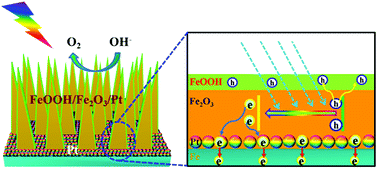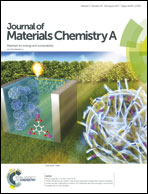One-dimensional hematite photoanodes with spatially separated Pt and FeOOH nanolayers for efficient solar water splitting†
Abstract
Charge separation plays a crucial role in determining the solar energy conversion efficiency of semiconductors for photoelectrochemical (PEC) water splitting. However, owing to the intrinsically high electron–hole recombination, the generally reported PEC performance is still far below that expected. Therefore, we have attempted to demonstrate that efficient charge separation can be achieved on the selective growth of spatial FeOOH cocatalyst and Pt nanoparticles on hematite photoanodes. Unlike traditional strategies – single cocatalyst decoration or element doping – this comprises an interfacial hole-transfer layer as the active sites (FeOOH) for water oxidation, and an electron collector and transfer layer (Pt) to facilitate water reduction. Here we demonstrate a simple but effective “bottom-up” method, combined metallic replacement with hydrolytic reactions, for the selective growth of the FeOOH cocatalyst (top) and Pt particles (bottom) on the hematite-nanoflake (NF) photoanodes. As expected, this novel FeOOH/α-Fe2O3 NF/Pt photoanode yields excellent photoresponse behavior for PEC water splitting reactions −2.0 mA cm−2 and 3.2 mA cm−2 obtained at 1.23 VRHE and at 1.5 VRHE under AM 1.5G illumination – which is much higher than the pristine hematite and/or exclusively FeOOH cocatalyst-decorated samples. These results demonstrate that selectively integrating electron and hole-transfer layers into photoanodes could effectively achieve spatial charge separation and greatly improve PEC performance for water splitting.



 Please wait while we load your content...
Please wait while we load your content...